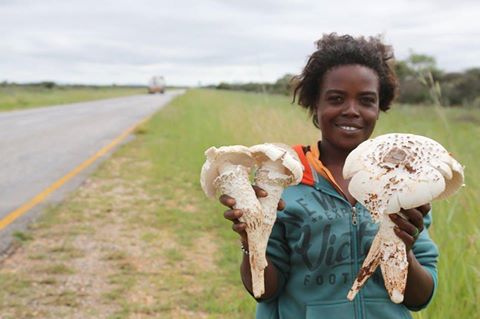It's Omajova feast time!
- 067triangle
- Jan 30
- 2 min read
In the 067 area, a unique seasonal spectacle unfolds as the rainy season breathes life into the savannah.
Along the main roads, eager sellers are waving massive mushrooms like flags, enticing motorists to hit the brakes for a taste of one of Namibia’s most cherished delicacies: Omajova.
Omajova emerge as a giant mushroom from the base of towering termite hills after the first rains, typically in late January, February, or March.
Weighing up to a kilogram each, they’re culinary heavy-weights, their unique flavor best savored fried in butter and sprinkled with a touch of salt. Omajovas owe their existence to the ingenious Macrotermes termites, which cultivate the Termitomyces fungus in their subterranean nests.
The termites and fungi share a symbiotic relationship: termites provide chewed-up plant material as a nutrient bed, while the fungi convert it into digestible food for their insect hosts. Once the rains arrive, the fungus sends up fruiting bodies -Omajovas - that break through the hard soil at the base of the termite mounds, ready for harvest.
For many Namibians, Omajovas supplement both diets and incomes, making them an invaluable seasonal resource.
Sustainable Harvesting
To ensure these delectable mushrooms remain a sustain-able resource, follow these essential harvesting guidelines:
Cut, don’t pull: Always cut the mushroom above the surface, leaving the root intact to sustain the termites.
Wait for the umbrella: Only harvest mushrooms once the hood has fully opened, allowing spores to be released for future growth.
Stay termite-bound: Mush-rooms found on the ground (not on termite mounds) could be poisonous impos-ters - best to avoid them.
From termite hill to table
Whether you buy them roadside or harvest them yourself, chefs agree Omajovas are a delight in the kitchen.
Fry them in butter, pair them with cherry tomatoes and asparagus, stuff them into an omelette, or wrap them in slivers of smoked salmon.
Their meaty texture and earthy flavor make them a perfect canvas for culinary creativity.
Beyond their taste, Omajovas are a testament to Namibia’s natural ingenuity - from the masterfully engineered termite mounds to the delicate balance of ecosystems they sustain. So next time you see a giant mushroom waved next to the roadside, stop, indulge, and savor Namibia’s omajova feast!














Comments